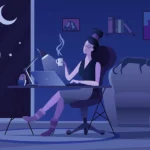Artificial Intelligence (AI) is increasingly being adopted across many industries to varying degrees. The question we’re looking at in this post is ”how can AI help digital creatives”?
AI tools aimed at digital creativity fall into three categories: inspiring creativity; streamlining creative workflows; AI-generating assets. These tools can be integrated into creative applications or standalone software and are already gaining widespread use.
Lets drill into more detail on what digital creatives can get out of using AI tools.
What Are Creative AI Tools?
Creative AI tools are those that utilize artificial intelligence to compliment the creative process. This can be either by creating workflow efficiencies or helping with inspiration. They can also be used to generate original pieces of artwork using algorithms but there is debate around whether this is can be true art without the human element.
The main aim of creative AI tools is to enhance a designer or artist’s creativity rather than to replace it entirely. At least, this is the most effective use of the tools today. Even though there are tools that create original work, they are still derivative. They are based on inputs of existing data and use algorithms to generate new work from observed patterns Is this true creativity?
How Can AI Tools Be Used For Creativity?
There are a lot of creative AI tools on the market, either as stand-alone software or those integrated into wider software packages. It may surprise you to learn that tools you use on a daily basis may already contain an AI-assisted function.
The majority of tools are aimed at enhancing creativity rather than replacing it and these can range from idea generation all the way through to image editing. This is really where these tools can shine and help creatives every day to achieve quicker and better results.
Tools aimed at generating their own creative work at this stage are more of an experiment to push the limits of AI rather than being of actual use. They can be considered as projects by programmers or philosophers to distill the meaning of creativity and push the technical limits of computer programming.
Is the end-product of one of these tools really something that a customer would seek out? Artwork designed by artificial intelligence? This is likely a niche product at best.
Creative AI tools can be broken down into three main purposes:
- Inspire creativity;
- Increase the efficiency of the creative process;
- Create AI-generated art or designs
Idea Generation
Particularly useful for designers are creative tools that assist with idea generation or “ideation”. These work by loading learning data into an algorithm and teaching it to generate alternative versions or combinations of designs. These types of tool can really help to speed up workflows where many iterations of a design are required on the road to selecting those most suitable.
The algorithm most widely used is known as a Generative Adversarial Network (GAN) algorithm.
AI-Generated Art
The Generative Adversarial Network (GAN) algorithm can also be used to create new images by synthesizing a large number of source images.
Each piece is technically unique but because it is derivative from other artworks could be considered to not be true art by some.
One example of a tool already on the market is Artbreeder which allows feeding in of two sets of images to synthesize a new one. For example dogs and pandas to then create a dog that has the fur pattern and color similar to a panda. Whilst this is high in novelty value and amusement is it really art? It could be argued that it is just another tool at an artist’s disposal and the creativity comes from the way that it is used.
Another similar tool is Deep Dream Generator which uses neural networks to transfer styles from a source image to a target image. Adobe Photoshop’s neural filters also include a similar feature.
Using an algorithmic tool such as these opens up new customization possibilities and business models. What if an artist created a number of source images and you were able to select your favorites and feed them into an AI tool to create your won unique piece of art based on that of the original artist and then buy it from them?
Enhancing Artwork
Some tools use AI to assist artists in manipulating images by generating new pixels. This can help speed up workflows or achieve more realistic enhancements than the artist might be capable of or have the time to carry out.
A great example of this is with Adobe Photoshop’s neural filters which uses AI to make various enhancements. These include ageing faces, changing expressions, zooming into photos beyond their resolution limitations or transferring art styles to name but a few.
Make sure to check out my post What Are Photoshop Neural Filters? for a greater insight into its capabilities.
Music
When it comes to music creation, there are no shortage of AI creative tools for all stages of the process.
Many tools aim to create original compositions based on sample inputs and human-tweaked settings. For example, creating a composition to fit a selected mood, genre or tempo for use as a license-free soundtrack for a video.
AI-tools can even take a sample soundtrack, deconstruct it and reassemble it to match key points in a video. Some tools will also create music in real time based on human inputs allowing a perpetual stream of music.
Another common use is to stimulate creativity by helping discover new music phrases, beats or styles. Tools can use neural networks to suggest the next logical musical phrase or blend two distinctive tracks into a new style.
AI-creative tools for music can also speed up the creative process by organizing sample collections or generating draft vocals as a temporary placeholder until a more mature composition requires a human vocalist.
Is it Cheating to Use AI Creativity Tools?
AI-creativity tools vary in scope and can therefore be used in a number of ways. Many tools are simply that. Tools. These are used to speed up workflows in terms or organization or iteration of human creativity to mature an idea faster. These tools are no different to the advent of the computer at the time of the typewriter.
Pushing the boundary further are tools that serve to inspire human creativity by presenting different combinations of sample images or music into new combinations and styles. The human artist can then use these as a jumping-off point to create their own original work.
A philosophical argument comes into play more when original artwork or compositions are being made and then sold directly as unique pieces rather than simply for inspiration. This discussion centers around what true creativity is and whether a machine can achieve this any different to a human mind.
Will AI Creative Tools Replace Designers or Musicians?
It is unlikely that AI creative tools will replace designers or musicians. They will however most likely change the role of the creative individual as some tasks can be accomplished more quickly and easily by a machine. This leaves the artist to concentrate more on the core creative task and less so on the realization.
It has always been the case that technology has replaced more lower skilled tasks to allow humans to concentrate on more complex ones. AI creative tools are already capable of less demanding tasks such as making a unique soundtrack for a simple YouTube video or editing images to age faces but they still require instruction from the user.
What is the Future of AI Tools for Creativity?
The likely future of AI creativity tools is for the reduction of lower skilled creative tasks and speeding up workflows. This will allow professionals to concentrate on the core creative tasks and less on the peripheral ones.
Since AI creative tools work differently to the human brain, there is value in using its outputs as inspiration, taking creations in new directions than a human may not have thought of.
With regards to unique AI-generated pieces of art or music, the ceiling for these will be less dictated by the technical limitations, which will doubtlessly be overcome with time, but more about the consumer’s appetite for machine-generated content vs that from a human. If the novelty wears off and there is no market then AI-generated art will be resigned to stock image collections rather than the art museum.
If you enjoyed this post then you may be interested to read Create Digital Art & Designs While Traveling: Complete Guide.
Featured image: besjunior / stock.adobe.com
Adobe, Adobe Creative Cloud and Photoshop are either registered trademarks or trademarks of Adobe in the United States and/or other countries.








